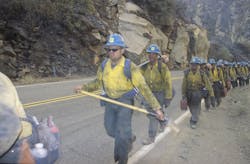Why Employers Have a Responsibility to Protect Workers from Wildfire Smoke
From Canada to Maui, wildfires and hazardous air quality are making headlines across North America. But while wildfire smoke presents a danger to everyone, employees who work outside face heightened health risks.
Though there are currently no federal regulations in place when it comes to hazardous air quality, contractors and organizations must recognize their responsibility and protect workers from wildfire smoke.
This commitment to employee well-being not only aligns with the principles of corporate social responsibility, but underscores the significance of creating a safe work environment. By taking steps to mitigate the effects of wildfire smoke, contractors can demonstrate their dedication to the health and safety of their workforce.
Despite a lack of federal mandates, organizations bear responsibility for worker safety
The Environmental Protection Agency (EPA) and the Occupational Safety and Health Administration (OSHA) do not have mandates on when outdoor work should cease due to hazardous air quality. However, despite the absence of regulations at a federal level, every employer is responsible for providing a safe work environment for their employees.
Wildfire smoke and hazardous air quality exposure pose serious risks to workers — especially older workers and those with preexisting conditions — and can trigger impacts such as coughing, difficulty breathing, and irritation of the throat, eyes and lungs. Prolonged exposure to poor air quality can even result in long-term health complications like heart attacks or stroke. Clearly, contractors have a duty to protect their workers from these health risks.
Environmental, social and corporate governance (ESG) strategies are top-of-mind for many organizations, and prioritizing worker safety is a critical component of any ESG strategy.
Failing to provide a safe work environment could have serious financial and reputational consequences. As a result, every organization needs to create a resilient and adaptable strategy to better protect its workforce in the face of evolving environmental challenges.
3 steps to protect workers from poor air quality
The EPA has shown that wildfire risks are increasing due to climate change. This heightened risk emphasizes the urgent need for proactive planning, training and agility to ensure a safe work environment.
Here are three steps you can take to protect your workers from hazardous air quality:
1. Implement safe and proactive work practices
Proactive planning and safe work practices are paramount to ensuring the well-being of workers during wildfire season. Regularly monitor the air quality index (AQI) so you can stay informed and make timely adjustments to operations when necessary.
When AQI values rise above 150, the air quality is classified as unhealthy for general populations. However, when AQI values exceed 300, the air quality shifts into a hazardous category, presenting immediate risks to individuals outdoors. In these instances, exercise heightened vigilance to safeguard your workforce and consider suspending work operations.
You can also minimize smoke exposure by shifting tasks to areas with better air quality ratings and reducing physical demands during periods of compromised air quality. Additionally, enable employees to take frequent breaks in areas with no exposure and proper HVAC systems.
2. Provide appropriate PPE
If work must continue when smoke is present, provide personal protective equipment (PPE), including proper respiratory protection.
Because compromised air quality presents serious health risks, equipping employees with NIOSH-approved N95 respirators, if not already integrated into their PPE ensemble, is essential when wildfire smoke is present. For employees who are working inside, use high-efficiency air filters to minimize potential health risks.
3. Encourage a culture of safety
Provide regular safety training to create a culture of safety and prepare employees to identify risk factors. For example, a simple initiative might involve helping employees assess personal risk factors (e.g., age and pre-existing health conditions) that may leave them more vulnerable to the effects of wildfire smoke.
A culture of safety empowers workers to voice their concerns and advocate for additional protective measures, if needed. You should also remain willing to adapt when environmental risks arise. Data and analytics tools can help you stay agile and keep track of breaks and worker safety trends so you can ensure everyone receives a respite from smoke.
Even though there are no federal mandates in place for hazardous air quality, worker safety should always be of paramount importance. With safe work practices like regular air quality monitoring, proper PPE and a culture of safety, you can ensure your employees feel protected and secure on the job.
Duane Duhamel is director of health, safety & environment at ISN.
About the Author

Duane Duhamel
Duane Duhamel is, Director of Health, Safety & Environment at ISN
